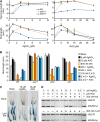Silver ions increase auxin efflux independently of effects on ethylene response
- PMID: 19903871
- PMCID: PMC2798329
- DOI: 10.1105/tpc.108.065185
Silver ions increase auxin efflux independently of effects on ethylene response
Abstract
Silver nitrate and aminoethoxyvinylglycine (AVG) are often used to inhibit perception and biosynthesis, respectively, of the phytohormone ethylene. In the course of exploring the genetic basis of the extensive interactions between ethylene and auxin, we compared the effects of silver nitrate (AgNO(3)) and AVG on auxin responsiveness. We found that although AgNO(3) dramatically decreased root indole-3-acetic acid (IAA) responsiveness in inhibition of root elongation, promotion of DR5-beta-glucuronidase activity, and reduction of Aux/IAA protein levels, AVG had more mild effects. Moreover, we found that that silver ions, but not AVG, enhanced IAA efflux similarly in root tips of both the wild type and mutants with blocked ethylene responses, indicating that this enhancement was independent of ethylene signaling. Our results suggest that the promotion of IAA efflux by silver ions is independent of the effects of silver ions on ethylene perception. Although the molecular details of this enhancement remain unknown, our finding that silver ions can promote IAA efflux in addition to blocking ethylene signaling suggest that caution is warranted in interpreting studies using AgNO(3) to block ethylene signaling in roots.
Figures


Similar articles
-
An ethylene and ROS-dependent pathway is involved in low ammonium-induced root hair elongation in Arabidopsis seedlings.Plant Physiol Biochem. 2016 Aug;105:37-44. doi: 10.1016/j.plaphy.2016.04.002. Epub 2016 Apr 2. Plant Physiol Biochem. 2016. PMID: 27074220
-
Boron deficiency inhibits root cell elongation via an ethylene/auxin/ROS-dependent pathway in Arabidopsis seedlings.J Exp Bot. 2015 Jul;66(13):3831-40. doi: 10.1093/jxb/erv186. Epub 2015 Apr 28. J Exp Bot. 2015. PMID: 25922480 Free PMC article.
-
Aluminium-induced inhibition of root elongation in Arabidopsis is mediated by ethylene and auxin.J Exp Bot. 2010;61(2):347-56. doi: 10.1093/jxb/erp306. Epub 2009 Oct 25. J Exp Bot. 2010. PMID: 19858117 Free PMC article.
-
Ethylene Inhibits Root Elongation during Alkaline Stress through AUXIN1 and Associated Changes in Auxin Accumulation.Plant Physiol. 2015 Aug;168(4):1777-91. doi: 10.1104/pp.15.00523. Epub 2015 Jun 24. Plant Physiol. 2015. PMID: 26109425 Free PMC article.
-
Deciphering Auxin-Ethylene Crosstalk at a Systems Level.Int J Mol Sci. 2018 Dec 14;19(12):4060. doi: 10.3390/ijms19124060. Int J Mol Sci. 2018. PMID: 30558241 Free PMC article. Review.
Cited by
-
Fine-tuning of root elongation by ethylene: a tool to study dynamic structure-function relationships between root architecture and nitrate absorption.Ann Bot. 2016 Oct 1;118(4):607-620. doi: 10.1093/aob/mcw123. Ann Bot. 2016. PMID: 27411681 Free PMC article.
-
The role of silver ions in the regulation of the senescence process in Triticum aestivum.Turk J Biol. 2018 Dec 10;42:517-526. doi: 10.3906/biy-1802-95. eCollection 2018. Turk J Biol. 2018. PMID: 30983866 Free PMC article.
-
Synthesis methods impact silver nanoparticle properties and phenolic compound production in grapevine cell cultures.Sci Rep. 2025 Mar 5;15(1):7667. doi: 10.1038/s41598-025-85545-7. Sci Rep. 2025. PMID: 40044708 Free PMC article.
-
ZmmiR169q/ZmNF-YA8 is a module that homeostatically regulates primary root growth and salt tolerance in maize.Front Plant Sci. 2023 Jun 28;14:1163228. doi: 10.3389/fpls.2023.1163228. eCollection 2023. Front Plant Sci. 2023. PMID: 37457348 Free PMC article.
-
Phenotype Switching in Metal-Tolerant Bacteria Isolated from a Hyperaccumulator Plant.Biology (Basel). 2021 Sep 7;10(9):879. doi: 10.3390/biology10090879. Biology (Basel). 2021. PMID: 34571755 Free PMC article.
References
-
- Alonso, J.M., Hirayama, T., Roman, G., Nourizadeh, S., and Ecker, J.R. (1999). EIN2, a bifunctional transducer of ethylene and stress response in Arabidopsis. Science 284 2148–2152. - PubMed
-
- Benavente, L.M., and Alonso, J.M. (2006). Molecular mechanisms of ethylene signaling in Arabidopsis. Mol. Biosyst. 2 165–173. - PubMed
Publication types
MeSH terms
Substances
Grants and funding
LinkOut - more resources
Full Text Sources

